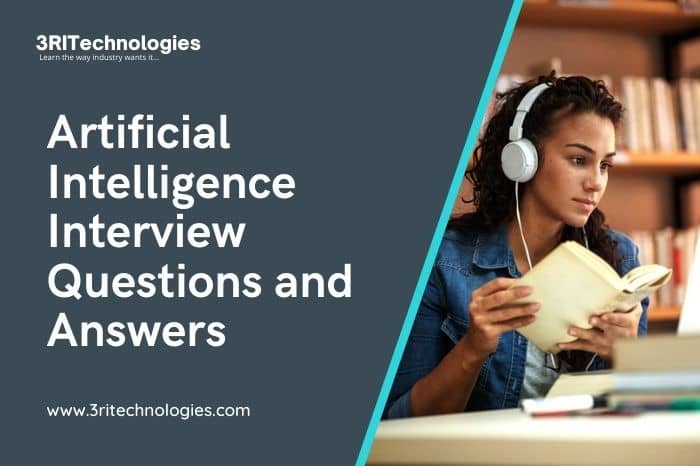Preparing for a role in AI requires a deep understanding of the core elements of artificial intelligence and the ability to articulate them clearly. This guide provides a comprehensive list of artificial intelligence interview questions to help you stand out. We have curated the most relevant ai interview questions and answers that cover both theory and practical application, ensuring you are prepared for any scenario. These artificial intelligence interview questions and answers are designed to test your problem-solving skills and technical knowledge. To build a truly expert foundation and confidently tackle any challenge, enroll in our industry-leading Artificial intelligence courses in pune and take the next step in your career.
From Core Elements to Advanced Scenarios: Your Ultimate AI Interview Guide
Since we learned how Artificial Intelligence is positively affecting the economy, almost every big company has been on the lookout for AI experts to help them achieve their vision. We have compiled the most often asked Artificial Intelligence Interview Questions.
The following are the most popular Artificial Intelligence interview questions and Answers.
What is Artificial Intelligence?
Artificial Intelligence is a field in computer science that focuses on the cloning of human behavior. Intelligent machines can act, think and decide just like a human. So it has two words: artificial and intelligence, meaning human-made thinking ability.
We don’t need to pre-program a machine to execute a process with artificial intelligence; instead, we can create a device with pre-programmed algorithms that can work independently.
Why is Artificial Intelligence required?
Artificial intelligence aims to develop intelligent machines capable of copying human behavior. In today’s world, AI is needed to solve complicated problems, making our lives easier by automating routine tasks, saving human resources, and performing various other jobs.
Explain specific real-world AI applications.
AI has a large variety of applications in the real world, some of which are described below:
● Google Search Engine: As we keep writing things into the Google search engine, we automatically receive relevant recommendations from various AI technologies.
● Ridesharing Apps: Ride-sharing apps like Uber use AI and machine learning to determine the type of ride, reduce the time once the user hails the car, and determine the price of the ride, and many other things.
● E-mail Spam Filters: AI is used for filtering spam e-mail to ensure that you receive only relevant e-mails. Gmail, according to reports, successfully filters 99.9% of spam e-mails.
● Social networking: AI is used by various social networking sites such as Facebook, Instagram, Pinterest, and others for different purposes, including face recognition and friend suggestions when uploading photos on Facebook, recognizing emoji context value in Instagram, respectively.
● Product recommendations: when we search for an Amazon product based on the different machine learning algorithms, we recommend similar products. We also get personalized recommendations for Netflix movies and web series.
Describe the types of AI?
Artificial intelligence can classify into many groups based on its skills and functions.
● Weak AI: Weak AI can carry out intelligently a limited set of tasks. Siri is the Example of Weak AI.
● General AI: Machines that are intelligent enough to execute some intellectual activity as well as a human.
● Strong AI: This is a theoretical concept in which a machine will surpass human intelligence.
Explain the types of Machine Learning?
Machine learning can be classified primarily into three different types:
● Supervised learning: it is a form of machine learning where machines use external supervision to learn from data. A named dataset is used to train the supervised learning models. The two critical problems that Supervised Machine Learning can solve are regression and classification.
● Unsupervised learning: A kind of machine learning under which a machine learns from data without external monitoring. The unlabeled dataset is used to train unsupervised models. These are used to solve the problems of association and clustering.
● Reinforcement learning: Agents interact with their surroundings in reinforcement learning by producing action and learning from its feedback. The agent receives feedback in rewards, such as a positive reward for each successful effort and a negative reward for each lousy action. There is no supervision over the agent. The Q-learning Algorithm is employed for reinforcement learning.
Interested to begin a career in AI? Enroll now for Artificial Intelligence Training in Pune.
Explain the term Q-Learning.
In reinforcement learning, Q-learning is a popular algorithm. It’s based on the equation of Bellman. The agent in this Algorithm tries to learn policies that can include the right actions to maximize rewards under specific circumstances. Through previous experiences, the agent knows the best policies.
The agent’s aim in Q-learning is to optimize the value of Q, which is used to represent the quality of the behavior at each state.
Explain deep learning and how does it work in the real world?
It’s a machine learning technique that shows how the human brain works. It’s based on the concept of neural networks to solve complex real-world problems, and it’s inspired by human brain cells known as neurons.
How is Machine learning related to AI?
Artificial intelligence has a subset called machine learning. It is a way to get AI. Both concepts are distinct, and the relationship is understandable as AI uses various algorithms and concepts of the machine to solve complex problems.
What is Markov’s Decision process?
The Markov decision process or MDP can be used to solve a reinforcement learning problem. MDP is then used to formalize RL. The mathematical method can be used to solve a problem in reinforcement learning. This process’s primary objective is to achieve the possible benefits by selecting the best policy.
MDP has four elements, which are:
● A set of finite states S
● Policy Pa
● Rewards
● A set of finite actions A
In this process, the agent takes action A to move from state S1 to S2 or state to the end state, and the agent receives rewards for doing these actions. Thus, the policy is the series of actions taken by the agent.
Explain the reward maximization?
In reinforcement learning, the term reward maximization is used, which refers to the goal of the reinforcement learning Agent. In RL, a reward is a constructive response to moving from one state to another. For example, if the agent takes good action by following optimal policies, he is rewarded, and if he does an evil act, he penalizes. The agent aims to optimize these rewards by implementing the best strategies possible, a process known as reward maximization.
Describe parametric and non-parametric models?
Two types of machine learning models are available, parametric and non-parametric. The parameters are called the predictor variables used to build the machine learning model. These models are described as follows:
● Parametric Model: The ML model produces parameters in parametric models using the specified number of parameters. It takes into account strong data assumptions. Logistic regression, Linear regression, perceptron, respectively, are parametric models.
● Non-Parametric Model: In a non-parametric model, the number of parameters is flexible, and It takes into account a few data assumptions. These models work well with large amounts of data and no prior knowledge. Non-parametric models include the K – nearest neighbor, Decision Tree, Gaussian kernels, SVM, and others.
What is hyperparameter?
The parameters that determine and control the entire training process in machine learning are known as hyperparameters. Learning rate, Hidden Layers, Hidden Units, Activation functions, and other parameters are examples of these parameters. These parameters aren’t part of the model. A better algorithm can be made by choosing good hyperparameters.
Describe the Hidden Markov model.
The Hidden Markov model represents a statistical model that defines the probability distribution over a chain of observations. The secret model Markov assumes the state of the process generated at a particular time would be hidden from the observer. In contrast, Markov believes that the process fulfills the property of Markov. HMM, models are often used for temporal data.
Give a brief introduction to the Turing test in AI?
The Turing test is among the most commonly performed artificial intelligence tests. In the year 1950, Alan Turing launched the Turing test. It’s a test to see whether a machine would think like a human or not. According to this test, a computer is only considered intelligent if it can copy human responses under specific conditions.
Three players are involved in this test:
- A robot
- A human responder
- A human interrogator
The interrogator must determine which response is from the machine based on questions and answers.

Tell one technique to avoid overfitting in neural networks?
Dropout Technique: One of the most common strategies for avoiding overfitting in neural network models is the dropout technique. It’s the regularization technique in which neurons are dropped at random during training.
Looking for more details? visit 3RI Technologies
What role does computer vision play in AI?
Computer vision is an artificial intelligence branch aimed at training robots to interpret and obtain information such as images from a visual world. As a result, computer vision employs artificial intelligence (AI) to solve complex challenges like image processing and object detection.
What is game theory? How is it essential in AI?
The logical and scientific study of possible interactions between two or more rational players is known as game theory. Every player thinks that the other players are reasonable and have the same level of knowledge and understanding as they do. In a multi-agent scenario, players deal with a given range of options in game theory, which means that one player’s choice affects the choices of other or competing players.
Game theory and artificial intelligence are closely connected and mutually beneficial. Game theory is commonly used in AI to allow some of the critical capabilities needed in a multi-agent environment. For example, several agents try to interact with each other to achieve a goal.
Various popular games, such as Poker and Chess, are logical games with specific rules. To play these games online or digitally, such as on a mobile phone or a laptop, one must first develop algorithms for them. And artificial intelligence is used to apply these algorithms.
What are the eigenvalues and eigenvectors?
The two fundamental principles of linear algebra are eigenvectors and eigenvalues.
● Unit vectors with a magnitude of 1.0 are called eigenvectors.
● The coefficients applied to the eigenvectors, or the magnitude by which the eigenvector is scaled, are called eigenvalues.
What is a Chatbot?
A chatbot is an artificial intelligence software or an entity that simulates a conversation with humans or users using the natural language processing method. For example, an application, a website, or messaging applications may be used to have a conversation. These chatbots, also known as digital assistants, can interact with humans via text or voice.
AI chatbots, such as HDFC Eva chatbot and Vainubot, are widely used in most companies to provide virtual customer support to their customers 24 hours a day, seven days a week.
Describe reinforcement learning?
Reinforcement Learning is a machine learning technique. In this case, an agent interacts with its environment by producing behaviors and learns through feedback. The feedback is provided to the agent in rewards, like a positive reward for each excellent action and a negative reward for the wrong move. The agent is not supplied with any labeled data or supervision. To explore the environment in RL, the agent constantly does three things: perform actions, change state, and receive feedback.
The following are the reinforcement learning algorithms:
● Deep Q Neural Network
● State Action Reward
● Q-Learning
Describe rational agents and the concept of rationality.
A rational agent has simple preferences, models uncertainty, and regularly does the right actions. In any case, a rational agent can take the best possible move. Therefore, the quality of being reasonable and sensitive and having a good sense of judgment refers to rationality.
What is tensor flow, and how is it used in AI?
The Google Brain team developed TensorFlow, an open-source library platform. It’s a math library with a range of apps for Machine learning. We can quickly train and use tensor flow to implement machine learning models in the cloud.
How can you describe a market basket analysis?
The market basket analysis is a common way of assessing the relationships between items. Big retailers also do this for profit maximization. In this method, we need to find combinations of products mostly bought together.
When a person buys bread, for example, there’s a good chance he’ll also buy butter. As a result, recognizing such correlations will assist retailers in growing their company and providing consumers with relevant offers.
Describe the Bayesian network in AI?
The Bayesian networks define a graphic model for showing the probabilistic relationship between the number of variables. It’s a directed cycle graph with several edges, each of which represents a conditional dependency.
As the Bayesian network is based on probability distribution and uses probability for estimating and detecting anomalies, it is probabilistic. It’s essential in AI because it’s based on the Bayes theorem and can answer probabilistic questions.
Explain the heuristic function?
For the most promising direction, informed searches use the heuristic function. It takes the agent’s current state as input and produces an estimation of how near the agent is to the target. On the other hand, the heuristic approach does not always provide the best solution. A heuristic function decides the close condition to the desired goal. The cost of an ideal route between two states is calculated and expressed by h(n). Thus, the heuristic function’s value is always positive.
What is a depth-first search algorithm?
DFS (depth-first search) is based on LIFO. The LIFO stack data structure is used to implement recursion. As a result, the nodes are not in the same order as in BFS. In each iteration, the path is stored linearly from root to leaf nodes, with space requirement.
What is a bidirectional search algorithm?
The search is a bidirectional algorithm that starts and works its way back to the objective state. The investigations are coming together to find a shared state. Reversibly, the initial state and the goal state are linked. Each search is only carried out up to half of the aggregate time.
Describe the iterative deepening depth-first search algorithm?
In this search, the level 1 and level 2 repetitive search processes occur. The search continues to find a solution. Nodes are formed until a single node is created. Saved the node stack.
Explain the uniform cost search algorithm?
Sorting is utilized to increase the cost of the path to a node in uniform cost search. At a low cost, it expands the node. If the price of each iteration is the same, it is the same as BFS. It explores methods in increasing cost order.
Explain Alpha-Beta pruning.
Alpha–Beta pruning is an algorithm that tries to reduce the search for the minimum Algorithm to the number of nodes searched in the search tree. It can prune entire subtrees and leaves and can be applied to n depths.
What is fuzzy logic?
Fuzzy logic is an artificial intelligence branch, which encodes artificial learning in human learning. It’s a kind of logic with a lot of various values. IF-THEN rules are used to represent it.
What is FOPL?
The formal system of each statement is divided into a subject, and a predicate called the logic for first-order predicate logic. The predicate only applies to one subject and can change or define the properties of the subject.
What is Naive Bayes?
A robust algorithm for predictive modeling is the Naive Bayes Machine Learning algorithm. It is a set of algorithms based on a common principle inside the Bayes theorem. Naive Bayes’ fundamental assumption is that each feature applies to the final result equally and independently.
What is Perceptron in Machine Learning?
Perceptron is a supervised classification algorithm that simulates the human brain’s ability to understand and discard data. The input is classified into one of several non-binary outputs.
Explain the model accuracy and model performance?
Model accuracy, a model performance subset, is based on the model performance of an algorithm. The model’s performance is based on the datasets we include as algorithm inputs on the other side.
Explain the methods used for reducing dimensionality?
Dimensionality reduction is a technique for reducing the number of random variables. To reduce dimensionality, techniques such as the missing values ratio, low variance filter, high correlation filter, random forest, and others can be used.
Explain an Expert System?
An expert system, also known as an Artificial Intelligence program, has expert-level knowledge of a particular data set and uses that information to react appropriately. These systems can solve real-world challenges without the need for a human expert.
What is the Tower of Hanoi?
It is a mathematical puzzle that demonstrates how to construct an algorithm using recursion to solve a specific problem. The Tower of Hanoi can be solved by artificial intelligence with a decision tree and an algorithm for breadth-first search (BFS).
Check out AI Training in Pune. Enroll now!
What is partial order planning?
Instead of searching for all possible situations, partial-order planning searches through the space of possible plans. The partial-order plan defines all activities that must perform, but only when they are required. The goal is to piece together a plan.
A partial-order plan specifies all of the measures you’ll need to complete but only the order of the stops when it’s required.
Explain the Neural Network?
Neural networks are an emulation in artificial intelligence of a bio-neural system that receives data, processes data, and gives output based on algorithms and empirical data.
Describe the frames and scripts?
Frames are a semantic network, which is a usual form of expressing expert system non-procedural knowledge. Frame, a structure of artificial data, divides information by reflecting stereotyped situations into the substructure. Scripts are like frames, except that the values must be ordered in the slots. In natural language understanding, script(s) are used to organize a knowledge base to understand the situation.
How many terms are needed to build a Bayes model?
Three terms are used to construct a Bayes model in AI; one conditional probability and two unconditional probabilities.
What conditions had to be met in Inductive Logic Programming?
Inductive Logic Programming aims to generate a series of sentences that satisfy the entailment constraint for the hypothesis.
For probabilistic temporal reasoning, what Algorithm is used?
HMM (Hidden Markov Model) is used to solve probabilistic temporal reasoning, independent of the transformation or sensor model.
Conclusion
This article has artificial intelligence interview questions that will help you in passing the interview.







